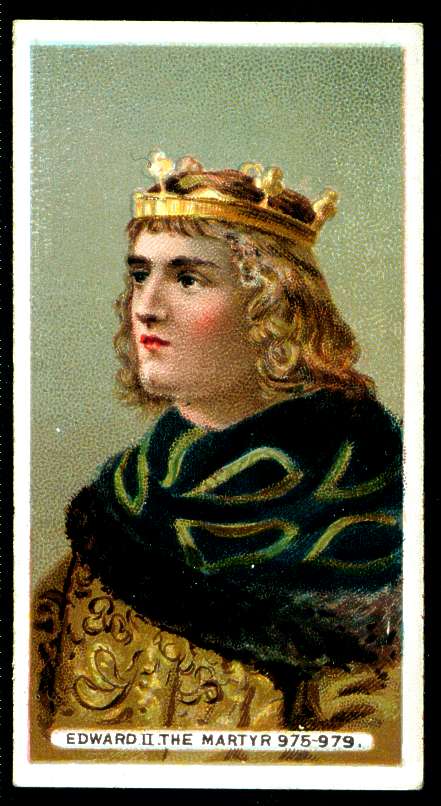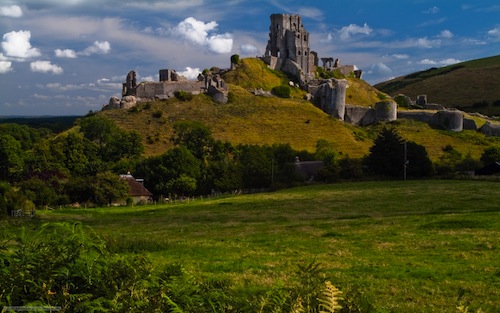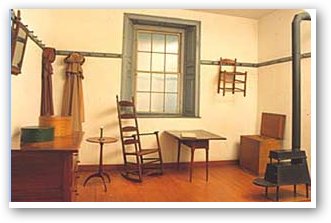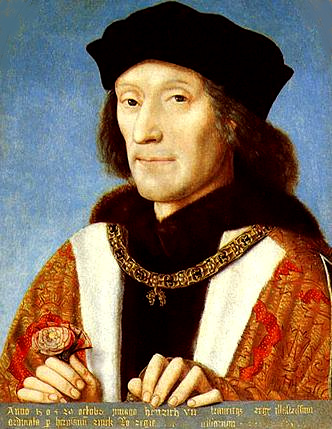Name: King Edward The Martyr
Born: c.963
Parents: Edgar and Ethelfleda
Relation to Elizabeth II: 28th great-granduncle
House of: Wessex
Ascended to the throne: July 8, 975
Crowned: 975 at Kingston-upon-Thames, aged c.13
Married: Unmarried
Children: None
Died: March 18, 978 at Corfe Castle (murdered)
Buried at: Wareham reburied Shaftesbury
Reigned for: 2 years, 8 months, and 10 days
Succeeded by: his half brother Ethelred
 Elder son of King Edgar, he succeeded to the throne as a boy of 12, and in so doing, aroused rival claims to the throne from his even younger half-brother, Aethelred II, the Unready. During his short reign, he spent most of the time indulging in hunting and womanising. He was eventually murdered by his wicked step-mother, Queen Aelfthrith, so that her own son, Ethelred (the Unready) could inherit the English throne. He was killed at Corfe Castle after a hunting expedition, buried first at Wareham and then translated to Shaftesbury Abbey (all in Dorset) where he was elevated to sainthood. Along with Edmund of East Anglia and Edward the Confessor, he has always been considered one of the three true Patron Saints of England. His supposed bones were dug up last century and quickly became the subject of a major court battle when one of the joint-owners gave them away to the Russian Orthodox Church in Brookwood (Surrey)!
Elder son of King Edgar, he succeeded to the throne as a boy of 12, and in so doing, aroused rival claims to the throne from his even younger half-brother, Aethelred II, the Unready. During his short reign, he spent most of the time indulging in hunting and womanising. He was eventually murdered by his wicked step-mother, Queen Aelfthrith, so that her own son, Ethelred (the Unready) could inherit the English throne. He was killed at Corfe Castle after a hunting expedition, buried first at Wareham and then translated to Shaftesbury Abbey (all in Dorset) where he was elevated to sainthood. Along with Edmund of East Anglia and Edward the Confessor, he has always been considered one of the three true Patron Saints of England. His supposed bones were dug up last century and quickly became the subject of a major court battle when one of the joint-owners gave them away to the Russian Orthodox Church in Brookwood (Surrey)!
He was murdered by members of Aethelred’s household at Corfe Castle in 978.
At his death, King Edgar the Peaceful had left two sons, the elder of these, Edward, was the child of his first marriage to Elfleda, the daughter of Ealdorman Ordmaer.
Elfleda had been divorced in around 964 to enable Edgar to marry his second wife, Elfrida, a notorious character and widow of Ethelwald, Ealdorman of East Anglia, who was said to have had an adulterous affair with the King prior to her first husband’s death. This second marriage produced two further sons, Edmund and Ethelred , but the elder of these had predeceased his father.
Elfrida was crowned Queen on 11th May, 973, at Bath Abbey, which was the first instance of a coronation of a Saxon Queen of England. She was the first consort to be termed Queen since the infamous Judith, daughter of Charles the Bald, in the previous century.
His father’s will named his elder son, Edward, (or Eadweard in Old English) as his heir and he had the support of the influential but now aged St. Dunstan, Archbishop of Canterbury. Many of the nobility of the realm, including the powerful Alfere, Ealdorman of Mercia were in favour of the seven year old Ethelred succeeding, as they themselves had much to gain from the crown being subjected to a long minority government. The nation was divided over the issue of which of his sons should suceed King Edgar. A meeting of the witan was arranged at Calne, in Wiltshire were the matter was debated at length. Eventually, the influence of Dunstan prevailed and accordingly Edward was elected King
Edward was crowned by St. Dunstan at Kingston upon Thames in 975, at the age of thirteen. After recording Edward’s succession, the Anglo-Saxon Chronicle reports that a comet appeared, and that famine and “manifold disturbances” followed.
Despite what had passed, the two brothers, Ethelred and Edward themselves seem to have remained attached to each other. Queen Elfrida, however, thoroughly detested her step-son. At her instigation, plot was hatched to murder the young King.
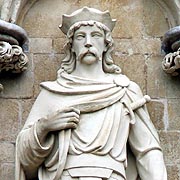 Edward visit his half-brother Ethelred at Corfe, in the Purbeck Hills of Dorset, probably at or near the mound on which the ruins of Corfe Castle now stand, in the evening of 18 March 978, at the invitation of his step-mother. Elfrida met him at the door with a kiss of welcome. He was then offered the traditional drink to refresh him. As the young King heartily refreshed his thirst after the dusty journey, one of the Queen’s attendants treacherously stabbed the sixteen year old in the back. Though severely wounded, he managed to spur his horse and escaped, making an attempt to re-join his companions, but died on the road. His bloody corpse, dragged in the stirrups by the terrified animal, revealed his fate to his attendants.
Edward visit his half-brother Ethelred at Corfe, in the Purbeck Hills of Dorset, probably at or near the mound on which the ruins of Corfe Castle now stand, in the evening of 18 March 978, at the invitation of his step-mother. Elfrida met him at the door with a kiss of welcome. He was then offered the traditional drink to refresh him. As the young King heartily refreshed his thirst after the dusty journey, one of the Queen’s attendants treacherously stabbed the sixteen year old in the back. Though severely wounded, he managed to spur his horse and escaped, making an attempt to re-join his companions, but died on the road. His bloody corpse, dragged in the stirrups by the terrified animal, revealed his fate to his attendants.
Edward was buried at Wareham and his murder went unpunished. Said to deeply repent this deed, Queen Elfrida became a nun at Wherwell Abbey in Hampshire. She died in 1002.
The Cult of Edward the Martyr
 Edward’s body lay at Wareham for a year before being disinterred. Ælfhere initiated the reinterment, perhaps as a gesture of reconciliation. According to the life of Oswald, Edward’s body was found to be incorrupt when it was disinterred (which was taken as a miraculous sign). The body was taken to Shaftesbury Abbey in Dorset, a nunnery with royal connections which had been endowed by King Alfred the Great and where Edward and Æthelred’s grandmother Ælfgifu had spent her latter years. A cult dedicated to the martyred King sprang up, bringing pilgrims flocking to Shaftesbury to seek miracles at his shrine. At the Dissolution of the Monasteries, Edward’s relics were hidden by the monks to escape desecration.
Edward’s body lay at Wareham for a year before being disinterred. Ælfhere initiated the reinterment, perhaps as a gesture of reconciliation. According to the life of Oswald, Edward’s body was found to be incorrupt when it was disinterred (which was taken as a miraculous sign). The body was taken to Shaftesbury Abbey in Dorset, a nunnery with royal connections which had been endowed by King Alfred the Great and where Edward and Æthelred’s grandmother Ælfgifu had spent her latter years. A cult dedicated to the martyred King sprang up, bringing pilgrims flocking to Shaftesbury to seek miracles at his shrine. At the Dissolution of the Monasteries, Edward’s relics were hidden by the monks to escape desecration.
During the course of an excavation of the Abbey in 1931, they were unearthed by a Mr. Wilson-Claridge. An examination of the relics took place in 1970, when Edward’s skeletal remains, remarkably intact, were examined by the forensic pathologists of the British Home office. They concluded that the remains were those of a young man of about 20, (Edward was 17 when he died) and were able to detail with remarkable accuracy all of his injuries, from his broken ribs and ankle and fractured skull due to the dragging, to the nick from the assassins’ blades on his spinal column, thus confirming the historical account of his death.
Wilson-Claridge wanted the relics to go to the Russian Orthodox Church Outside Russia. His brother, however, wanted them to be returned to Shaftesbury Abbey. For decades, the relics were kept in a bank vault in Woking, Surrey because of the unresolved dispute about which of two churches should have them They were later donated to the Russian Orthodox Church Outside Russia, which had Edward’s remains reburied at Brookwood Cemetery, Woking, Surrey.
| Timeline for King Edward The Martyr |
| 975 | 13 year old Edward succeeds to the throne |
| 978 | Edward the Martyr murdered at Corfe Castle |

